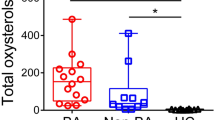Abstract
To clarify whether an abnormal bile acid pattern has a role in the pathogenesis of Alagille syndrome, we compared serum bile acid patterns in seven with Alagille syndrome with those of patients with congenital biliary atresia (CBA), neonatal hepatitis (NH) and normal infants.
Of the seven patients with Alagille syndrome, four patients were younger and three were older than 1 year. The mean total serum bile acid level in the infants was higher than in older subjects. There was a dissociation between the levels of serum total bile acid and bilirubin in three of the seven cases. The mean total bile acid levels in serum were in the following decreasing order: CBA, Alagille syndrome, NH and controls.
The ratio of cholate to chenodeoxycholate in the younger patients with Alagille syndrome was significantly higher than CBA (P<0.001). However, no specific bile acid pattern was found in Alagille syndrome by high-performance liquid chromatography (HPLC).
Similar content being viewed by others
Abbreviations
- TBA:
-
total bile acids
- FBA:
-
free bile acids
- conj-BA:
-
conjugated bile acids
- C/CDC:
-
ratio of cholate to chenodeoxycholate
- G/T:
-
ratio of glycine conjugates to taurine conjugates
- GPT:
-
glutamic pyruvic transaminase
- CBA:
-
congenital biliary atresia
- NH:
-
neonatal hepatitis
- HPLC:
-
high performance liquid chromatography
- GCA:
-
glycocholate
- TCA:
-
taurocholate
- GCDCA:
-
glycochenodeoxycholate
- TCDCA:
-
taurochenodeoxycholate
References
Alagille D (1979) Intrahepatic neonatal cholestasis. In: Javitt NB (ed) Neonatal hepatitis and biliary atresia. Goverment Printing Office, Washington, USA, pp 177–194
Alagille D, Odievre M, Gautier M, Dommergues JP (1975) Hepatic ductular hypoplasia associated with characteristic faces, vertebral malformations, retarded physical, mental, and sexual development, and cardiac murmur. J Pediatr 86:63–71
Arisaka O (1981) Studies on the enterohepatic circulation of bile acids in infancy and childhood. Part 1. Acta Pediatr Jpn 23:341–352
Collins DM, Shannon FT, Campbell CB (1981) Bile acid metabolism in mild arteriohepatic dysplasia. Aust NZ J Med 91:520–527
Hanson RF, Isenberg JN, Williams GC, Hackey D, Szczepanik P, Klein PD, Sharp HL (1975) The metabolism of 3α, 7α, 12α-trihydroxy-5β-cholestan-26-oic acid in two siblings with cholestasis due to intrahepatic bile duct anomalies. J Clin Invest 56:577–587
Heathcote J, Deodhar KP, Schheuer PJ, Sherock S (1976) Intrahepatic cholestasis in childhood. N Engl J Med 295:801–805
Henriksen NT, Langmark F, Sørland SJ, Fausa O, Landaas S, Aagenaes Ø (1977) Hereditary cholestasis combined with peripheral pulmonary stenosis and other anomalies. Acta Paediatr Scand 66:7–15
Leven SE, Zarvos P, Milner SM, Schmaman A (1980) Arteriohepatic dysplasia: association of liver disease with pulmonary arterial stenosis as well as facial and skeletal abnormalities. Pediatrics 66:867–883
Linarelli LG, Williams CN, Phillips MJ (1972) Byler's disease; fatal intrahepatic cholestasis. J Pediatr 81:484–492
Niijima S (1985) Studies on the conjugating activity of bile acids in children. Pediatr Res 19:302–307
Nittono H (1979) Studies on the toxicity of bile acids on the hepatobiliary system in rabbits. Acta Pediatr Jpn 21:11–24
Odievre M, Martin JP, Hadchouel M, Alagille D (1976) Alpha-1-antitrypsin deficiency and liver diseases in children: Phenotypes, manifestations, and prognosis. Pediatrics 57:226–231
Okuyama S (1979) HPLC analysis of individual bile acids: free, glycine-and-taurine-conjugated bile acids. Gastroenterol Jpn 14: 129–134
Riely CA, Cotlier E, Jensen PS, Klatskin G (1979) Arteriohepatic dysplasia: A benign syndrome of intrahepatic cholestasis with multiple organ involvement. Anal Intern Med 91:520–527
Van Berge Henegouwen (1974) Is an acute disturbance in the hepatic transport of bile acids the primary cause of cholestasis in benign recurrent intrahepatic cholestasis. Lancet I:1249–1251
Watson GH, Miller V (1973) Familial pulmonary arterial stenosis with neonatal liver disease. Arch Dis Child 48:459–466
Williams CN, Kaye R, Baker L, Hurwitz R, Senior JR (1972) Progressive familial cholestasis and bile acid metabolism. J Pediatr 81:493–500
Author information
Authors and Affiliations
Rights and permissions
About this article
Cite this article
Obinata, K., Nakatsu, N., Watanabe, T. et al. Investigation of serum bile acids; seven patients with Alagille syndrome. Eur J Pediatr 144, 236–239 (1985). https://doi.org/10.1007/BF00451949
Received:
Accepted:
Issue Date:
DOI: https://doi.org/10.1007/BF00451949




